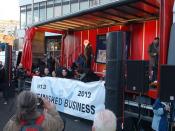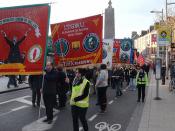THE POLITICS OF THE WORKING CLASS IN THE 20TH CENTURY
Working-class women used more radical, at times violent methods in their political activism. In the 1920s and 1930s employers took very little notice of the hardships of the labourers in the British-ruled Caribbean territories. Unemployment was high, ranging from 25 to 50 percent in some territories. Women were paid less than men, and health and educational facilities were poor. These conditions led to the outbreak of strikes and riots from Belize to Jamaica in the 1930s. In the absence of legally recognised trade unions, and denied the right to participate in government, working-class people used violent and non-violent protest. Women were very much a part of these struggles, although they are unknown.
Women in Belize were among the earliest to participate in the third wave of 20th-century protests motivated by economic concerns. They increasingly became dissatisfied with the colonial government, more demanding of political rights and were concerned about consumer rights.
In 1953, 400 workers in Belize City went on a strike organised by Elfreda Reyes in the quest for improved wages. In Trinidad, women took part in the demonstrations of unemployed workers in Port-of-Spain in 1933 and 1934, and in the spontaneous strikes on sugar estates in 1934. More riots broke out in 1937, this time involving a wider cross-section of the Indian and African-Trinidadian working class. There were similar strikes and riots in St. Kitts, St. Vincent and St. Lucia in 1935; in Barbados in 1937; in Jamaica in 1938 and in British Guiana in 1938 and 1939. There were riots over the high prices of consumer goods in St. Vincent in 1935.
POST-SLAVERY PROTEST AND ACTIVISM
Women protested over many issues in the years after the abolition of slavery. These issues were related to the injustices in...


